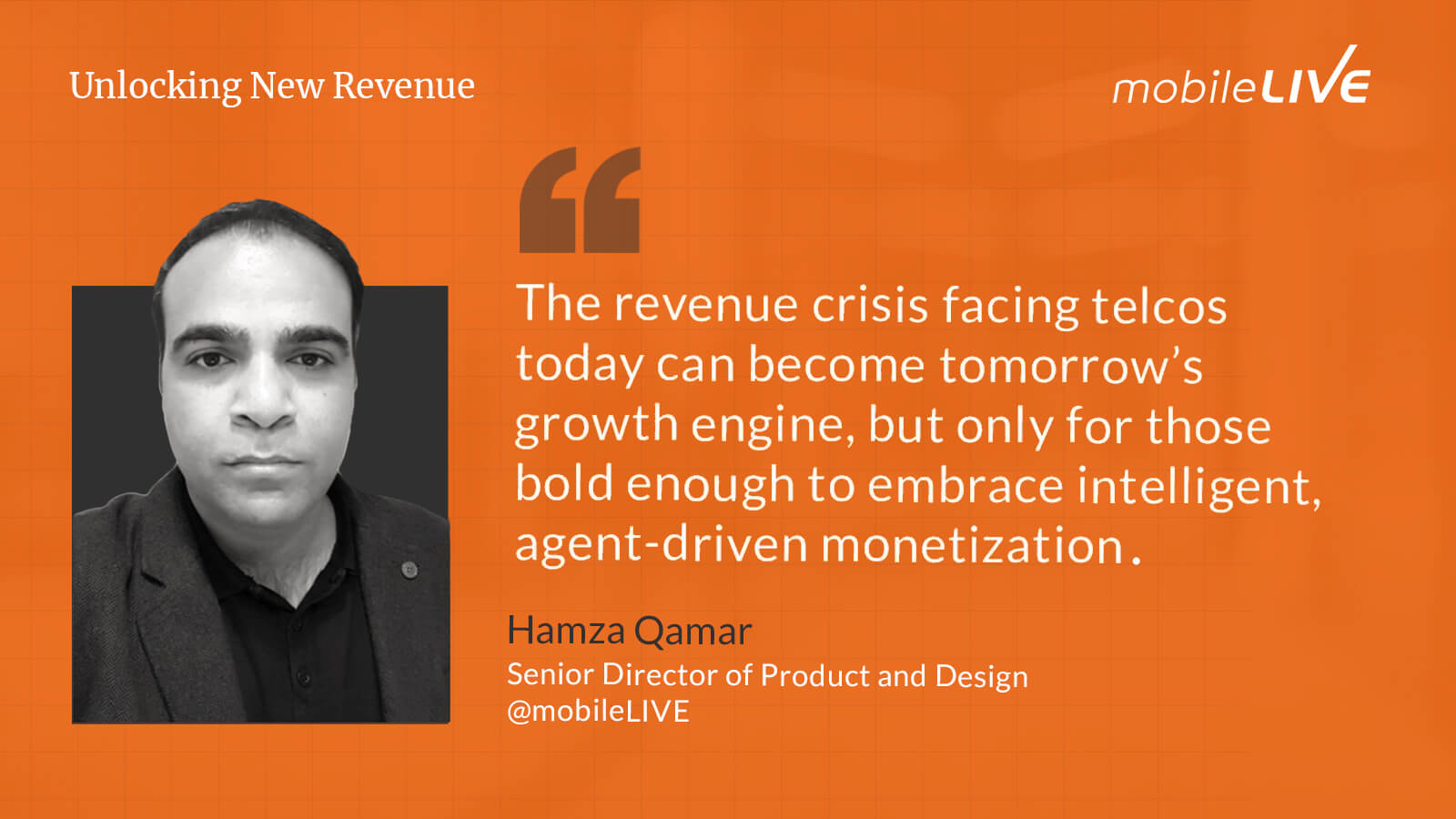
Jump To Section
- 1 The Telecom Revenue Crisis Demanding a Smarter Approach
- 2 What’s Causing the Monetization Stalemate in Telecom
- 3 What Makes Autonomous Agents “Agentic” in Monetization
- 4 Key Use Cases: Monetization By Integrating Agentic AI
- 5 Agentic AI Systems: Foundations for Telecom Transformation
- 6 The Impact of Integrating Agentic AI on BSS and Customer Channels
- 7 The Measurable Business Impact of Using AI Agents with Minimal Human Intervention
- 8 Case Study: Proactive AI-powered Churn Prevention for a Leading Telco
- 9 Implementation Roadmap for Agentic AI
- 10 Ethical and Regulatory Guardrails when using an AI Agent
- 11 The Future of Telecom Monetization with Agentic AI
Despite rising data consumption and digital investments, revenue growth in telecom has flatlined, and the industry is feeling the pressure.
With the average global ARPU grown less than 1% year-over-year, telecom operators are left stuck in a cycle of price wars, commoditized services, and shrinking margins.
The core issue? Traditional monetization models are too slow, too reactive, and too disconnected from real-time customer behaviour.
But a new path forward is emerging.
Agentic AI, a next-generation approach to autonomous decision-making, is enabling telcos to move beyond campaign-based monetization and toward real-time, autonomous revenue orchestration. These intelligent AI agents don’t just react; they learn, decide, and act across systems to unlock high-margin opportunities at scale.
This article explores how Agentic AI is reshaping monetization strategy in telecom, the operational and ethical implications leaders must consider, and the steps needed to move from stagnant growth to dynamic, data-driven revenue.
The Telecom Revenue Crisis Demanding a Smarter Approach
As traditional monetization strategies are failing to deliver sustainable growth, the telecommunications industry’s revenue challenges are becoming more severe than many operators realize.
Nearly half of global telcos are reporting stagnant or declining year-on-year ARPU growth in 2025, while many global operators struggle with commoditized voice and data plans that offer little differentiation. Traditional Business Support Systems (BSS) and marketing systems, built on rule-based architectures, are simply too slow and siloed to adapt to today’s dynamic market conditions.
While traditional AI operates within predefined rules, Agentic AI features autonomous agents that identify monetization opportunities and make real-time decisions across BSS and customer touchpoints to optimise revenue potential.
By leveraging the capabilities of Agentic AI, telecom operators may unlock previously untapped streams of income by dynamically adapting to market trends, user behaviours, and network demands.
These intelligent agents can swiftly react to fluctuations in demand, recommend personalised offers, and even automate intricate business processes, all while ensuring compliance with regulatory requirements.
However, successful adoption may require significant investment in infrastructure, robust data governance, and careful consideration of ethical implications related to autonomy and customer privacy. As such, integrating Agentic AI into existing systems presents both substantial opportunities and notable challenges for the telecommunications sector.
What’s Causing the Monetization Stalemate in Telecom
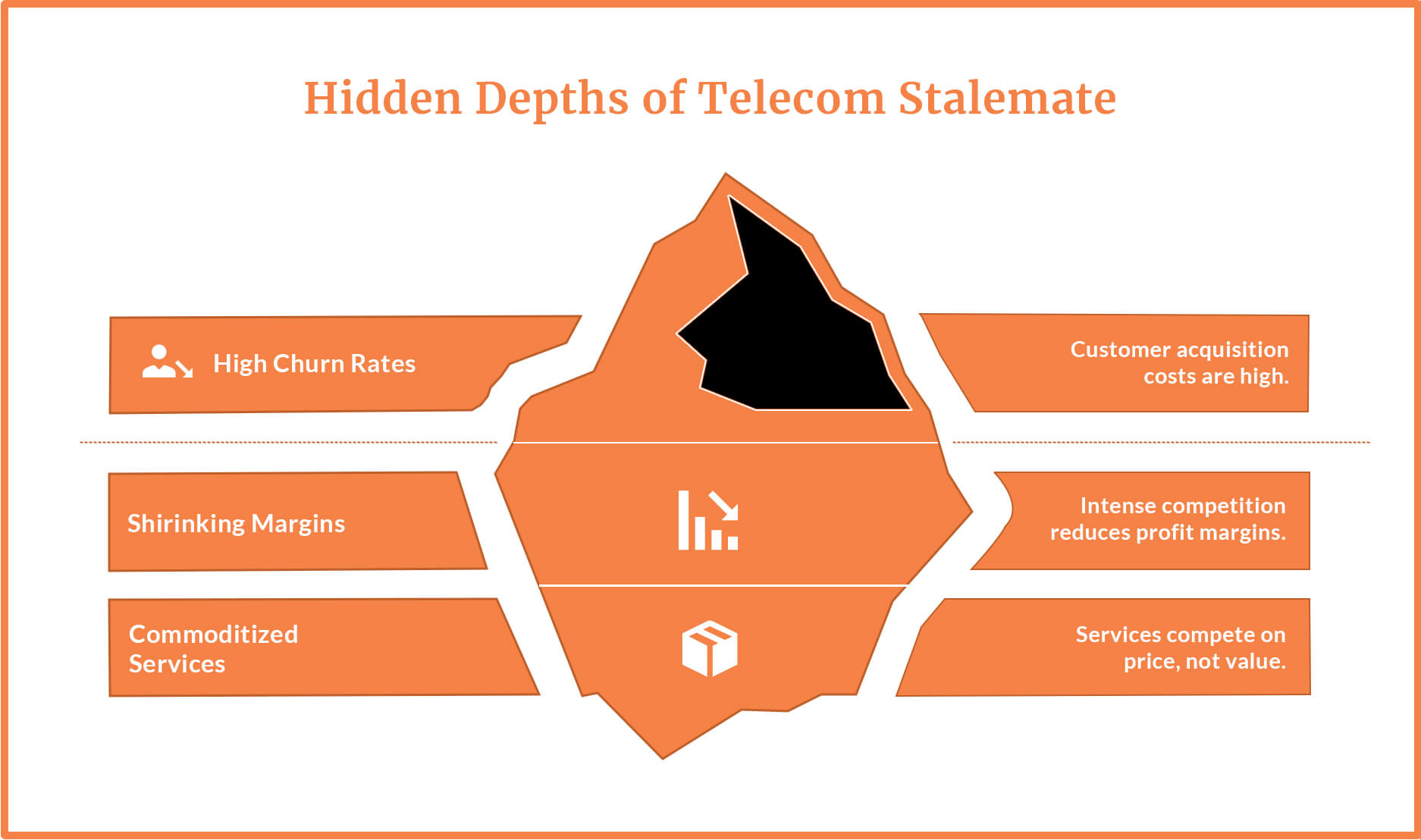
The root causes of this monetization stalemate are threefold:
- High churn rates continue to plague the industry, with customer acquisition costs often five times higher than retention costs.
- Shrinking margins result from intense competition and the inability to effectively price services based on real-time value delivery.
- Commoditized service offerings leave operators competing primarily on price rather than value, creating a race to the bottom that benefits no one. (voicendata)
What makes this particularly problematic is that traditional monetization approaches are fundamentally reactive. Campaigns take weeks to design and deploy, pricing strategies remain static for months, and customer engagement happens only after problems arise.
In a world where customer expectations change daily and competitive pressures intensify hourly, this reactive approach is a recipe for revenue decline.
What Makes Autonomous Agents “Agentic” in Monetization
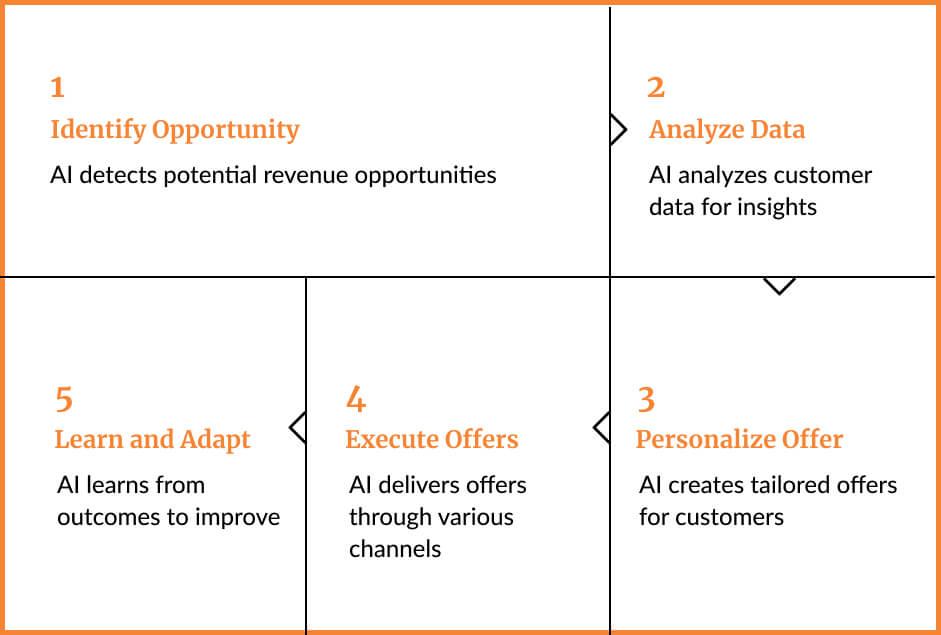
Agentic AI represents a paradigm shift from traditional automation to autonomous, goal-seeking intelligence. These systems are characterized by four key capabilities:
- Autonomous decision-making
- Real-time adaptation
- Multi-system orchestration
- Continuous learning.
AI agents operate as autonomous entities, making decisions and adapting to dynamic situations independently, which allows them to respond to changing business needs and optimize outcomes in real time.
In telecom monetization, this means AI agents that don’t just execute predefined rules but actively seek out revenue opportunities and optimize them in real-time.
The distinction is critical. While traditional AI might identify that a customer’s data usage has increased, an AI agent powered by agentic AI goes several steps further. It analyzes the usage pattern, identifies the optimal upsell opportunity, evaluates the customer’s propensity to accept the offer, executes the personalized proposal across multiple channels, and learns from the outcome to improve future interactions. This entire process happens autonomously, without human intervention, and in timeframes measured in seconds rather than weeks.
Multi-system orchestration is perhaps the most powerful aspect of an agentic ai system in telecom. These agents can seamlessly integrate with existing enterprise systems such as Customer Relationship Management (CRM), ERP, billing systems, supply chain, loyalty programs, HR tools, and product catalogs to execute complex monetization strategies end-to-end.
For example, an agent might detect a customer’s travel booking confirmation, instantly calculate the optimal roaming package based on destination and usage history, apply a personalized discount from the loyalty system, and deliver the offer through the customer’s preferred channel – all while updating billing configurations for automatic activation upon acceptance.
The continuous learning capability means these systems become more effective over time. Each interaction feeds back into the agent’s knowledge base, improving its understanding of customer behavior, market dynamics, and optimal pricing strategies.
Agentic AI can also analyze data from multiple sources to further enhance its performance and decision-making. This creates a compounding effect where monetization becomes increasingly sophisticated and effective as the system gains experience.
Agentic AI can be programmed to handle specific tasks within the monetization process, automating well-defined activities to increase efficiency and optimize revenue opportunities.
Key Use Cases: Monetization By Integrating Agentic AI
Agentic AI is revolutionizing how telecom operators approach monetization by enabling real-time, autonomous decision-making that goes far beyond traditional methods.
Through the deployment of AI-powered agents, telecom companies can dynamically tailor offers, optimize pricing, and automate complex workflows to unlock new revenue streams and enhance customer experiences.
If we look at some of the most impactful use cases where agentic AI is transforming telecom monetization, we see a demonstration of the ability of agentic AI to perform tasks with minimal human intervention while continuously learning and adapting to evolving market conditions.
1. Dynamic Bundling and Upselling
Traditional bundling strategies rely on static packages designed weeks or months in advance. Agentic AI transforms this into real-time, contextual bundling that responds to individual customer behavior as it happens. These AI agents continuously monitor usage patterns, streaming habits, IoT device connections, family data consumption and dynamically create personalized bundles that maximize both customer value and operator revenue.
By leveraging large language models and natural language understanding, these systems driven by AI agents can interpret complex customer needs and preferences. They also utilize diverse data sources—both structured and unstructured—to enhance personalization and ensure offers are highly relevant.
Consider this use case: An agent observes that a family’s data usage has increased by 40% over three months, driven primarily by multiple streaming services and smart home devices. Rather than waiting for the customer to exceed their data limit and become frustrated, the AI agent proactively creates a “Smart Family Bundle” that includes unlimited data, premium streaming subscriptions, and IoT device management services. The offer is personalized based on the family’s specific usage patterns and delivered at the optimal moment, perhaps when they’re researching streaming options or experiencing slow speeds.
The results speak for themselves. Companies implementing AI-driven personalization generate 40% more revenue than average players, while real-time bundling strategies can drive 8-12% ARPU uplift (tripica). The key is that these aren’t generic upsells but intelligently crafted solutions that genuinely address customer needs while maximizing revenue potential.
2. Micro-Moment Monetization for Complex Tasks
One application of Agentic AI is micro-moment monetization, which involves identifying and leveraging contextual opportunities that last only minutes or hours. In real-world, dynamic environments, these agents must rapidly adapt to changing conditions and customer needs. To do this effectively, agents may leverage external tools to gather contextual data and act quickly. These AI agents systematically observe customer behavior, location data, and external factors to detect short-term monetization possibilities that are challenging to address manually.
Examples include travel add-ons when booking flights are detected, gaming passes during e-sports events, emergency data during natural disasters, or premium connectivity during major sporting events. The agent recognizes the context, calculates the optimal offer, and delivers it through the most effective channel, all within minutes of the triggering event.
This approach transforms telecom operators from passive connectivity providers into proactive lifestyle partners. Instead of waiting for customers to request services, AI agents anticipate needs and fulfill them seamlessly. The revenue impact can be substantial: even small micro-moment campaigns can generate significant returns when executed across millions of customers at precisely the right moments.
3. Intelligent Credit and Loyalty Management
Traditional loyalty programs are typically not integrated with real-time customer behavior and billing systems. Agentic AI enables dynamic loyalty orchestration that adapts to customer actions as they occur. AI agents gather vast amounts of data from various sources to inform their decisions, allowing agents to automatically adjust loyalty points, offer credit extensions, or provide temporary service upgrades in response to specific situations, aiming to maintain customer engagement during critical periods. A multi agent approach can be used to manage complex loyalty scenarios, with multiple autonomous AI agents collaborating to deliver seamless and personalized experiences.
For instance, when an agent detects that a customer’s data usage will exceed their limit during an important business trip, it might automatically extend credit for additional data while simultaneously offering a discounted upgrade to a higher-tier plan. This removes friction at the exact moment it matters most while creating an opportunity for sustainable revenue growth. A detailed guide for modernizing legacy billing systems can be found here: The 4-Step AI Playbook for Telcos to Modernize Legacy Billing Systems
The intelligence extends to predictive credit management, where AI agents analyze payment patterns, usage trends, and economic indicators to optimize credit policies for individual customers using specialized models. This reduces bad debt while maximizing revenue opportunities, creating a win-win scenario for both operators and customers.
4. Cross-Sell Beyond Connectivity
The most transformative aspect of agentic AI in telecom is its ability to expand monetization beyond traditional connectivity services. These agents can intelligently promote ecosystem services including insurance, financial technology, content subscriptions, and IoT solutions, positioning telecom operators as comprehensive lifestyle and business partners.
This ecosystem monetization is particularly powerful because it leverages the operator’s unique customer data and billing relationships to create value in adjacent markets. Agentic AI can integrate with external systems to deliver value-added services, such as connecting with third-party platforms for seamless customer experiences. An agent might identify that a customer frequently travels for business and automatically suggest travel insurance, expense management tools, and international banking services, all delivered through the operator’s platform with streamlined billing and customer service. When orchestrating these offers, multiple AI agents may collaborate to provide comprehensive solutions tailored to the customer’s needs.
Revenue from value-added services in telecom is growing every year, and operators that successfully expand beyond connectivity can achieve significantly higher ARPU growth while reducing customer churn through increased service stickiness. Additionally, AI agents learn from customer responses to refine future offers, continuously improving cross-sell effectiveness over time.
Agentic AI Systems: Foundations for Telecom Transformation
Agentic AI systems are rapidly becoming the backbone of telecom transformation, empowering operators to address complex challenges with unprecedented efficiency.
Unlike traditional automation, these systems deploy autonomous agents capable of tackling complex tasks and making data-driven decisions with minimal human intervention. By harnessing vast amounts of data, agentic AI systems enable intelligent agents to learn continuously, adapt to changing environments, and execute specific tasks independently across diverse business processes.
At the core of these systems are advanced machine learning algorithms and natural language processing capabilities. This allows AI agents to understand and respond to customer service inquiries in real time, analyze customer intent, and automate complex workflows that once required significant manual oversight. As a result, telecom operators can deliver highly personalized and responsive experiences, anticipating customer needs and resolving issues before they escalate.
The power of agentic AI lies in its ability to operate independently, learning from every interaction and refining its approach to maximize both efficiency and customer satisfaction. These AI agents learn not only to streamline routine operations but also tackle complex tasks such as dynamic offer creation, real-time billing adjustments, and proactive service recommendations. By automating these processes, agentic AI systems free up human resources for more strategic initiatives, driving innovation and growth across the telecom sector.
Ultimately, the integration of agentic AI systems marks a pivotal shift for telecom operators. By enabling AI agents to learn from vast amounts of data and automate complex tasks with minimal human intervention, the industry can move beyond reactive service models to deliver proactive, personalized, and scalable solutions that meet the demands of today’s digital-first customers.
The Impact of Integrating Agentic AI on BSS and Customer Channels
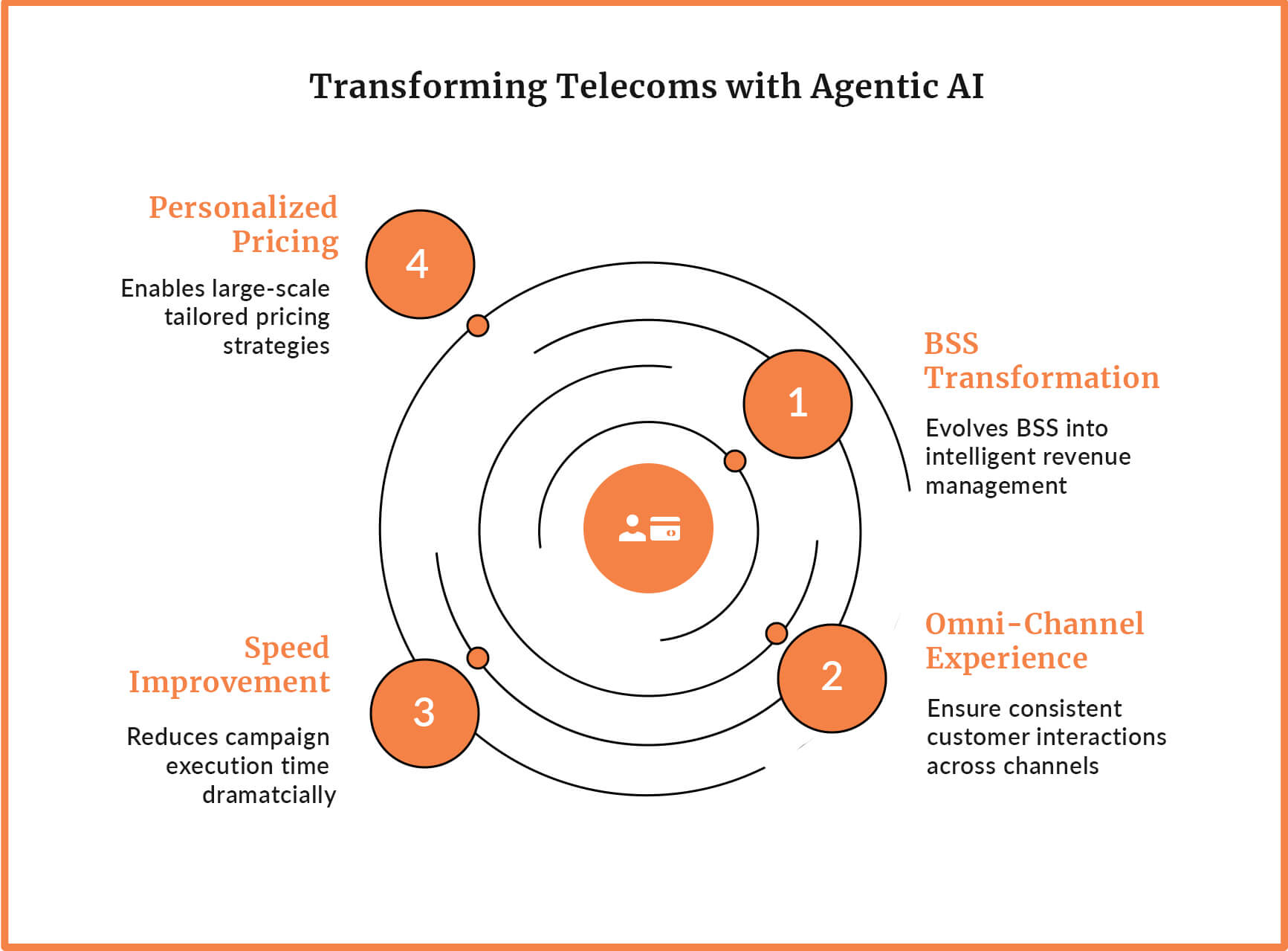
Agentic AI redefines Business Support Systems (BSS), evolving them from passive record-keeping platforms into sophisticated, intelligent revenue management solutions. While conventional BSS frameworks rely on predefined workflows and manual approvals, Agentic AI integrates autonomous decision-making functionalities.
This is enabled by a comprehensive AI system that manages complex processes and adapts through continuous learning. Agentic AI operates through autonomous agents and advanced orchestration, allowing collaboration, learning, and adaptation to optimize BSS performance. This enables the execution of advanced monetization strategies with minimal human intervention.
This transformation enables omni-channel experience consistency where offers and interactions appear seamlessly across mobile apps, WhatsApp, voice assistants, and point-of-sale systems. The agent ensures that regardless of how a customer chooses to interact with the operator, they receive consistent, personalized, and contextually relevant experiences.
The speed improvement is dramatic. Real-time execution reduces campaign lag from weeks to seconds, enabling operators to respond to market opportunities and customer needs with unprecedented agility. This speed advantage becomes a competitive moat, as operators with agentic AI can consistently outmaneuver competitors still relying on traditional campaign-based approaches.
Agentic AI makes large-scale personalized pricing and service possible, tailoring offers and configurations to each customer’s needs and value. Previously unattainable due to complexity, this level of customization is now routine with autonomous AI agents managing millions of relationships. The integration of agentic ai marks a pivotal shift in telecom operations, enhancing productivity and revolutionizing how organizations deliver value.
The Measurable Business Impact of Using AI Agents with Minimal Human Intervention
The financial impact of agentic AI in telecom monetization is both substantial and measurable.
- ARPU growth of 8-12% through real-time bundling and upsells represents the most immediate benefit, as agents continuously optimize service packages and pricing for individual customers. (mobiliseglobal)
- Reduced churn through autonomous retention achieves 20-30% decreases in voluntary churn, while AI-powered dynamic pricing can increase revenue by nearly 10% while cutting operating costs by up to 20%. These improvements compound over time as the systems learn and become more effective. (Camunda)
- Cross-selling into adjacent services creates entirely new revenue streams. Super apps, supply chain management, and ecosystem monetization can double ARPU for operators that successfully expand beyond traditional connectivity services. The key is that Agentic AI makes this expansion operationally feasible by managing the complexity of multi-service customer relationships autonomously. (exacaster)
- The operational benefits are equally significant. 63% reduction in average handling time, 50% increase in first-call resolution rates, and 49% uplift in transactional Net Promoter Score demonstrate that Agentic AI improves both efficiency and customer satisfaction simultaneously. Agentic AI also enhances employee productivity by automating manual processes, allowing staff to focus on higher-value activities. (telecoms)
Case Study: Proactive AI-powered Churn Prevention for a Leading Telco
A leading North American telco was struggling with high voluntary churn rates, primarily due to service quality concerns, billing disputes, and competitive market offers. Traditional churn prevention methods triggered only after customers expressed intent to leave, making retention reactive and costly.
The telco sought a forward-looking approach to predict and prevent churn proactively, protecting high-value customers and improving profitability.
The Challenge
Customer churn remained one of the largest drivers of revenue loss, with traditional retention programs failing to intervene early enough.
The lack of predictive capabilities meant the provider reacted only when customers contacted support to cancel services. This delayed response created three key problems:
- Limited visibility into early churn signals such as reduced engagement and competitive research behavior.
- High operational costs from blanket retention campaigns that lacked personalization.
- Inability to scale interventions without heavy manual oversight from retention teams.
The telco needed an autonomous, scalable solution powered by AI agents to detect churn risk earlier and act in real time without disrupting existing operations.
The Solution
Agentic AI-driven churn prevention was implemented by integrating predictive analytics with autonomous retention actions:
Early Signal Detection
AI models analyzed call quality metrics, billing disputes, customer support interactions, and usage trends to identify churn indicators weeks in advance, processing data from multiple sources to build a comprehensive risk profile.
Autonomous Intervention
When high churn risk was detected, the system automatically applied retention measures such as account credits, targeted perks, or priority support without requiring management approval, using real-time data to inform decision-making and ensure timely responses.
Closed-Loop Optimization
Continuous learning from outcomes allowed the system to refine predictive accuracy and retention strategies over time.
This agentic approach ensured high-value customers were proactively engaged with personalized retention offers, reducing dependency on manual campaign development. Automating routine tasks improved efficiency by freeing retention teams from repetitive workflows and allowing them to focus on more strategic initiatives.
The Impact
- 20-30% reduction in voluntary churn among high-value customers.
- 35% lower call center costs due to automated retention campaigns.
- 60% improvement in first-contact resolution rates, boosting customer satisfaction.
- Significant revenue protection, as retaining a single high-value customer yielded higher ROI than acquiring multiple new ones.
Implementation Roadmap for Agentic AI
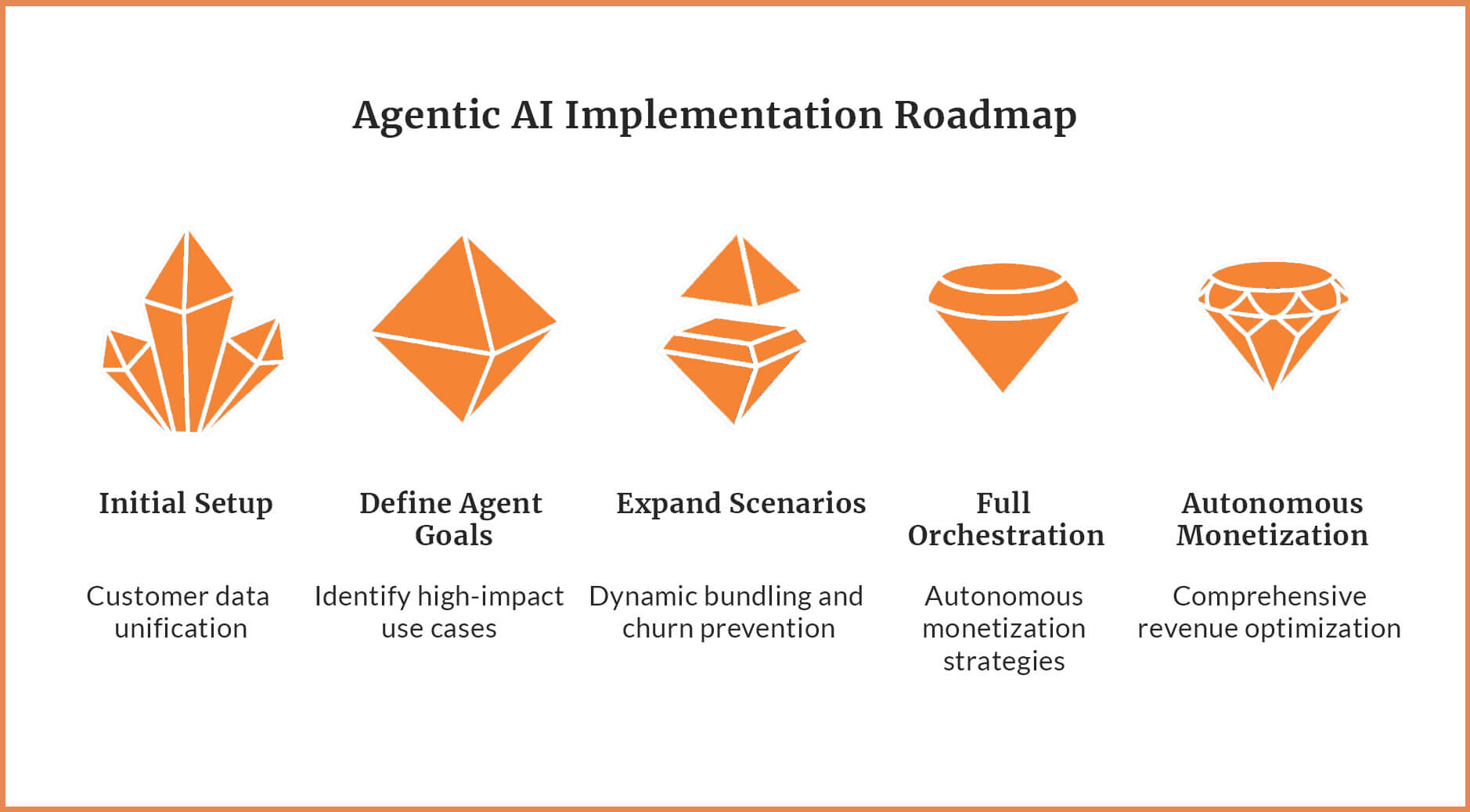
Successfully implementing agentic AI for telecom monetization requires a structured approach that balances ambition with practical execution. Integrating agentic AI with existing systems is crucial to ensure seamless operation and maximize value. The journey begins with customer data unification to create a single, comprehensive view of each customer across all touchpoints and systems.
Phase 1: Foundation Building
Phase 1 focuses on defining agent goals and identifying high-impact use cases. Start with low-risk monetization flows such as add-on services, loyalty point allocation, and micro-credit extensions. This allows the organization to build confidence and expertise while delivering immediate value.
Phase 2: Strategic Scaling
Phase 2 expands to more complex scenarios including dynamic bundling, proactive churn prevention, and cross-channel offer orchestration. This phase requires deeper integration with BSS systems and more sophisticated agent training, with software development playing a critical role in building and deploying agentic AI solutions.
Phase 3: Full Orchestration
Phase 3 achieves full agent orchestration across BSS and digital touchpoints, enabling comprehensive autonomous monetization strategies. At this stage, agents can execute complex, multi-step revenue optimization campaigns that span weeks or months while adapting continuously to changing conditions.
The key to success is maintaining clear governance and oversight throughout the implementation process. While agents operate autonomously, they must do so within carefully defined boundaries that ensure compliance, customer satisfaction, and brand consistency.
During implementation, agentic AI can also streamline software development by automating repetitive tasks and optimizing workflows, further improving operational efficiency.
Ethical and Regulatory Guardrails when using an AI Agent
The power of agentic AI in monetization must be balanced with appropriate ethical considerations and regulatory compliance. Transparency in autonomous decisions is fundamental: customers should understand why specific offers are made and how their data is being used to create value. Human oversight remains crucial in agentic AI systems, as these agents can operate independently, raising important questions about control, safety, and decision-making responsibility.
Compliance with telecom billing and data privacy regulations becomes more complex when agents are making autonomous decisions at scale. Operators must ensure that all actions carried out by agentic AI comply with relevant regulations across all jurisdictions where they operate. The handling of sensitive information, such as patient data in healthcare AI applications, serves as a parallel, highlighting the need for robust privacy protections and secure management of customer data in telecom.
Customer consent for proactive monetization actions represents a new category of privacy consideration. While customers may appreciate valuable offers delivered at the right moment, they must have clear control over how extensively agents can act on their behalf.
The goal is to create systems driven by agentic AI that are not only effective but also trustworthy and sustainable. This requires ongoing investment in ethical AI practices, regular auditing of agent decisions, and continuous customer feedback integration.
The Future of Telecom Monetization with Agentic AI
The telecommunications sector faces changing customer expectations, increased competition, and stagnant growth from traditional monetization methods. Agentic AI offers a solution by enabling operators to move from campaign-based marketing to ongoing, automated revenue generation. This approach supports large-scale personalization, opens new revenue streams, and enhances customer experience.
Generative AI will also play a key role in future telecom applications, enabling automated content creation, advanced data analysis, and personalized customer interactions.
The operators that embrace this transformation will not only survive the current revenue challenges but emerge stronger and more profitable than ever. Those that continue to rely on traditional approaches risk becoming commoditized connectivity providers, competing primarily on price in an increasingly unsustainable market.
The future of telecom monetization isn’t more products, it’s smarter, agent-driven revenue orchestration. As agentic AI continues to automate routine tasks, staff will be freed from repetitive workflows and able to focus on higher-value, strategic activities. This shift from reactive campaigns to proactive, intelligent systems represents the most significant opportunity for revenue growth in the telecommunications industry’s modern history. The question isn’t whether this transformation will happen, but which operators will lead it and which will be left behind.
As agentic AI capabilities continue to mature and become more accessible, the competitive advantage will belong to operators that move quickly and decisively to implement these systems. The revenue crisis facing telecommunications today can become tomorrow’s growth engine, but only for those bold enough to embrace autonomous, intelligent monetization strategies powered by agentic AI.



